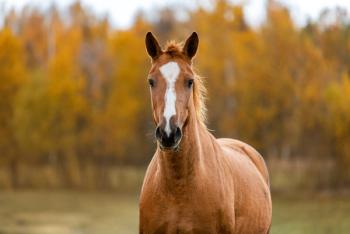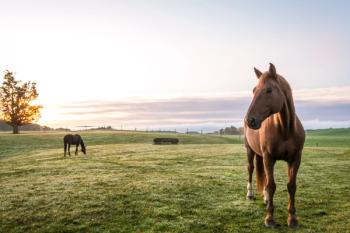
The Jockey Club announces project to identify at-risk racehorses
In June, The Jockey Club announced plans to develop a statistics-based system that would notify track officials and regulatory veterinarians when a horse that has been entered in a race is facing a heightened risk of injury. The Jockey Club hired Tim Parkin, BSc, BVSc, PhD, DECVPH, MRCVS, University of Glasgow School of Veterinary Medicine, to develop these at-risk protocols, based on the Equine Injury Database (EID). The project is expected to be complete in August 2012.
In June, The Jockey Club announced plans to develop a statistics-based system that would notify track officials and regulatory veterinarians when a horse that has been entered in a race is facing a heightened risk of injury. The Jockey Club hired Tim Parkin, BSc, BVSc, PhD, DECVPH, MRCVS, University of Glasgow School of Veterinary Medicine, to develop these at-risk protocols, based on the Equine Injury Database (EID). The project is expected to be complete in August 2012.
Parkin says the project provides an opportunity to identify the top risk profiles and focus interventions on the horses that fit those profiles. "With this system in place, we can identify the population of horses at markedly increased risk and potentially implement measures to mitigate that risk," he says.
According to The Jockey Club, using data from the EID, racing officials and regulatory veterinarians would receive automatic notifications from racing office software tools provided by InCompass Solutions Inc. The alerts would indicate, based on statistical analysis of patterns in past performances, when a horse presented a heightened risk of injury and needed a closer inspection. Those notices would be sent to regulatory veterinarians and racing office personnel at the racetrack.
"This development has the potential to be among the most significant advances in the safety of equine and human athletes," says James Gagliano, president and chief operating officer of The Jockey Club. "It's only possible because of the participation by racetracks in the EID, which now contains approximately 37,000 injury reports from 86 tracks, representing more than 92 percent of North American racing days."
The Jockey Club, through InCompass, will provide these tools to racetrack and regulatory officials for no additional fee and will be collaborating with the American Association of Equine Practitioners (AAEP) to develop the examination protocols that would assist regulatory veterinarians dealing with horses deemed at-risk.
Developing protocols
Larry Bramlage, DVM, DACVS, Rood & Riddle Equine Hospital and member of the Jockey Club EID Committee, says the endgame of the EID was always to try to learn enough about the injuries so that they can be prevented, not just documented after they occurred. During various meetings, discussions and conference calls with Parkin, the Jockey Club EID Committee asked him to look for specific parameters within the database that they might be able to use to determine which factors they could monitor.
The Jockey Club provided EID data for Parkin to analyze. This data was from Thoroughbred racehorses in North America and the corresponding control data from Equibase, which encompasses all of the starts that occurred during the same time interval. EID data is information collected relevant to cases in which regulatory veterinarians are required to intervene. It encompasses pre-race exam scratches to racing injuries and fatalities. But, for the purpose of this work, Parkin's risk factor identification is those of fatal cases only.
Fatalities were the case population, and the control population included all of the race starts made by horses during that same time period—about 1.5 million race starts.
"The injured population was compared against the uninjured population to identify trends, risk factors, risk markers, exercise history or race-related information that is consistent with an increased risk or a decreased risk," says Mary Scollay, DVM, Kentucky Horse Racing Commission and EID Committee member. "Not only were we looking for things that point out the horses with increased risk, but also those to identify things that appear to be protective. If we found factors that appear to be protective, people can elect to engage in those practices in order to increase the safety of their horses."
Bramlage says to determine when a horse becomes at higher risk for injury, one must know what the injuries are, document the database, and then see if there are commonalities in the database that point to an item that increases the horse's risk for injury. "Those will probably be twofold," he says. "One, the horse's bone characteristics and, second, the characteristics of the surfaces they are going over, which will include things like weather, maintenance and so on." Eventually, all of that data will be integrated.
He also says it doesn't really help to know that colts get injured more commonly than fillies, but if you were to say that the training pattern used on colts predisposes the horses to injury at a much higher rate than the training pattern used with fillies, then you might find the difference. In other words, how you're training a horse might be a key to preventing injury. Do the colts and fillies go the same number of high-speed training furlongs before they go to the races? Do they get a chance to get a layoff as often as the fillies do? Does the horse's sex have an effect when you look at the difference between the way colts and fillies are handled?
"From Parkin's analysis, we don't know what all of these data are going to show us," Bramlage says. "But we do know horses that are training after having a period of time off, depending on how long they've had off, have somewhat more porous bones than horses that are heavily training." On the other hand, he says, horses that are going on a lot of high-speed furlongs on a continuous basis—their bones get dense enough that they begin to get brittle. So, the ideal training path is somewhere in the middle. And that's what researchers want to find out.
Identifying risk factors
Scollay says this process is going to allow veterinarians to be more strategic in their response to horses with different characteristics. "When we identify a horse as being at increased risk, that doesn't mean the horse is going to be injured, but it means that it warrants additional scrutiny," she says. "By identifying that horse, we can then identify opportunities to better understand that horse's condition. That may mean physical inspections at times other than race day."
This tool could potentially be a huge benefit for racing regulatory veterinarians, Scollay says. It could enable them to understand which horses warrant more scrutiny so they can be more efficient in using limited resources to truly understand the conditions of those horses.
"For example, if a horse is sound, he's going to be sound any time you look at him," she says. "If a horse has physical limitations that could put him at risk of injury and you look at him enough times, you're probably going to get a more accurate picture of his condition than if you just look at him once."
Scollay also envisions the tracking system to be a valuable tool for trainers. "If they become aware of things that are associated with increased risk, they may monitor that horse differently than they would a horse that is in a low-risk category," she says. "This isn't saying that those horses can't race—it's not a blanket prohibition on their participation. Instead, it's saying this horse or this group of horses is different than another group of horses, and the difference is that they are in a group that is at increased risk of sustaining an injury. That means that that group needs increased protection."
It's hard to have a crystal ball into a particular horse's potential for injury. "We have to wait and see what the data tell us," Scollay says. "Hopefully, it will enhance our ability to protect these horses while allowing them to be the athletes that they are."
Ed Kane, PhD, is a researcher and consultant in animal nutrition. He is an author and editor on nutrition, physiology and veterinary medicine with a background in horses, pets and livestock. Kane is based in Seattle.
Newsletter
From exam room tips to practice management insights, get trusted veterinary news delivered straight to your inbox—subscribe to dvm360.






